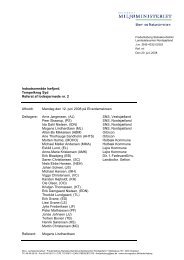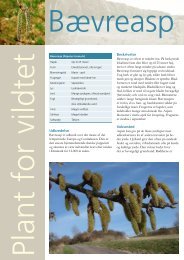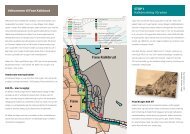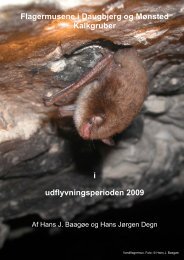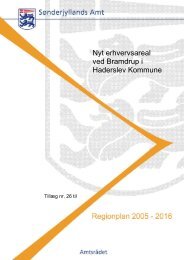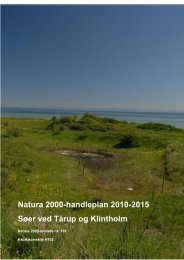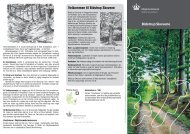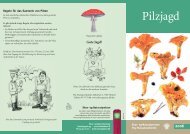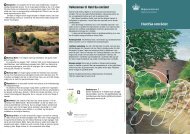Macroalgae and phytoplankton as indicators of ... - Naturstyrelsen
Macroalgae and phytoplankton as indicators of ... - Naturstyrelsen
Macroalgae and phytoplankton as indicators of ... - Naturstyrelsen
Create successful ePaper yourself
Turn your PDF publications into a flip-book with our unique Google optimized e-Paper software.
tial variation would give a better spatial description <strong>and</strong> reduce the r<strong>and</strong>om<br />
variation between sites.<br />
Coupling algal variables to water quality<br />
The variation in water quality variables w<strong>as</strong> initially analysed using a<br />
model similar to the algal model. The model describes water quality<br />
variables with respect to area-specific variation, site-specific variation,<br />
se<strong>as</strong>onal variation <strong>and</strong> year-to-year variation among hydrological years,<br />
i.e. July-June. For each water quality variable we calculated area-specific<br />
marginal means.<br />
Algal variables were related to physico-chemical variables through multiple<br />
regression analysis using backward elimination. First we introduced<br />
all the potential independent variables in the regression, <strong>and</strong> then excluded<br />
variables one by one until only the significant variables remained.<br />
The analyses were conducted on a spatial b<strong>as</strong>is to explain differences in<br />
algal parameters between various co<strong>as</strong>tal are<strong>as</strong>/sub-are<strong>as</strong>.<br />
Testing the "Spanish index" on Danish data<br />
A test <strong>of</strong> the "Spanish index" on Danish data dem<strong>and</strong>s some adjustment<br />
since Danish <strong>and</strong> Spanish algal data are collected differently <strong>and</strong> species<br />
composition <strong>and</strong> depth distribution differ. A first adjustment regards the<br />
definition <strong>of</strong> the three components <strong>of</strong> the index which also affects the<br />
data range <strong>and</strong> thus the scoring system. However, the principle <strong>of</strong> the<br />
scoring system, i.e. its depth <strong>and</strong> area dependence may also need adjustment<br />
for the index to be applicable under Danish conditions.<br />
Our approach for testing the "Spanish index" is the following:<br />
• Verify whether the individual components <strong>of</strong> the index reflect nutrient<br />
gradients in Danish co<strong>as</strong>tal waters since this is a prerequisite for<br />
including them in the index.<br />
• Identify whether each component is depth dependent <strong>and</strong> whether its<br />
level varies between are<strong>as</strong>, e.g. depending on salinity. This part <strong>of</strong> the<br />
test will tell us whether the principle <strong>of</strong> the Spanish scoring system<br />
can be transferred to Danish conditions.<br />
Below we explain how the "Spanish index" is defined <strong>and</strong> translated to<br />
Danish conditions <strong>and</strong> how the scoring system <strong>of</strong> the "Spanish index"<br />
operates.<br />
Definition <strong>of</strong> the three components <strong>of</strong> the "Spanish index"<br />
The first component <strong>of</strong> the index is the cover <strong>of</strong> characteristic species. In<br />
Spain, this variable is <strong>as</strong>sessed by estimating the percentage <strong>of</strong> the stable<br />
substratum <strong>of</strong> the sample area which is covered by 'characteristic species'<br />
<strong>as</strong> defined for Spanish are<strong>as</strong>. Characteristic species are those which are<br />
not opportunistic. We translate the Spanish 'characteristic species' to the<br />
Danish 'late-successional species'. The first component <strong>of</strong> the Spanish index<br />
is therefore approached by the Danish variable 'cumulated cover <strong>of</strong><br />
late-successional species'. The data range is 1-100% for the Spanish variable<br />
but may exceed 100% for the Danish variable.<br />
26



